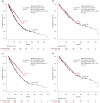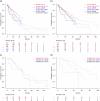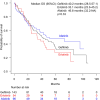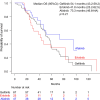Impact of First-Line Osimertinib and Other EGFR-Tyrosine Kinase Inhibitors on Overall Survival in Untreated Advanced EGFR-Mutated Non-small Cell Lung Cancer in Japan: Updated Data from TREAD Project 01
- PMID: 39302602
- PMCID: PMC11557658
- DOI: 10.1007/s11523-024-01094-5
Impact of First-Line Osimertinib and Other EGFR-Tyrosine Kinase Inhibitors on Overall Survival in Untreated Advanced EGFR-Mutated Non-small Cell Lung Cancer in Japan: Updated Data from TREAD Project 01
Abstract
Background: Osimertinib shows higher effectiveness than first-generation epidermal growth factor receptor (EGFR)-tyrosine kinase inhibitors (TKIs) in the initial treatment of EGFR-mutated non-small cell lung cancer. However, its superiority in terms of overall survival in the Asian population, especially Japanese patients, remains uncertain.
Objective: To evaluate the survival benefit of osimertinib over other EGFR-TKIs in Japanese patients, using real-world data. METHODS : As part of the Tokushukai REAl-world Data project, a retrospective multi-institutional study across 46 hospitals in Japan was conducted to evaluate the overall survival of patients with advanced EGFR-mutated non-small cell lung cancer using propensity score matching. The study involved patients receiving osimertinib as the first-line treatment (1L-Osi), those initially treated with other EGFR-TKIs (1L-non-Osi), and those receiving osimertinib after initial EGFR-TKI treatment (2L/later-Osi) between April 2010 and December 2022 and followed up until April 2023.
Results: Among 1062 Japanese patients with EGFR-mutated non-small cell lung cancer, 416 (39.2%) received 1L-Osi, while 646 (60.8%) received 1L-non-Osi, including 139 (13.1%) who received 2L/later-Osi. Within these groups, 416 (39.2%), 293 (27.6%), and 75 (7.1%) patients received first-line EGFR-TKI treatment post-osimertinib approval as a later-line treatment in Japan (March 2016). After propensity score matching, the overall survival of the 1L-Osi group was comparable to that of the 1L-non-Osi group in the post-March 2016 subset (n = 283, 42.0 vs 42.4 months). Similar trends were observed in the Del19 and L858R subgroups. The median overall survival of the 2L/later-Osi group was notably long: 60.2 months post-March 2016 (n = 75). A subgroup analysis based on initial EGFR-TKI treatment in the 1L-non-Osi and 2L/later-Osi groups revealed no significant differences among the gefitinib, erlotinib, and afatinib groups.
Conclusions: Based on real-world data, osimertinib did not show a significant improvement in overall survival compared to other EGFR-TKIs as a first-line treatment for EGFR-mutated advanced non-small cell lung cancer in the Japanese (Asian) population.
Clinical trial registration: This study was registered at the University Hospital Medical Information Network Clinical Trials Registry on 9 March, 2023 (identification UMIN000050552).
© 2024. The Author(s).
Conflict of interest statement
Figures






References
-
- Shi Y, Au JS-K, Thongprasert S, Srinivasan S, Tsai C-M, Khoa MT, et al. A prospective, molecular epidemiology study of EGFR mutations in Asian patients with advanced non-small-cell lung cancer of adenocarcinoma histology (PIONEER). J Thorac Oncol. 2014;9:154–62. 10.1097/JTO.0000000000000033. - PMC - PubMed
-
- Riely GJ, Wood DE, Ettinger DS, Aisner DL, Akerley W, Bauman JR, et al. Non-small cell lung cancer, Version 4.2024, NCCN Clinical Practice Guidelines in Oncology. J Natl Compr Canc Netw. 2024;22:249–74. 10.6004/jnccn.2204.0023. - PubMed
-
- Soria J-C, Ohe Y, Vansteenkiste J, Reungwetwattana T, Chewaskulyong B, Lee KH, FLAURA Investigators, et al. Osimertinib in untreated EGFR-mutated advanced non-small-cell lung cancer. N Engl J Med. 2018;378:113–25. 10.1056/NEJMoa1713137. - PubMed
-
- Uryu K, Imamura Y, Shimoyama R, Mase T, Fujimura Y, Hayashi M, et al. Stepwise prolongation of overall survival from first to third generation EGFR-TKIs for EGFR mutation-positive non-small-cell lung cancer: the Tokushukai REAl-world Data project (TREAD 01). Jpn J Clin Oncol. 2024;54:319–28. 10.1093/jjco/hyad162. - PubMed
Publication types
MeSH terms
Substances
LinkOut - more resources
Full Text Sources
Medical
Research Materials
Miscellaneous

